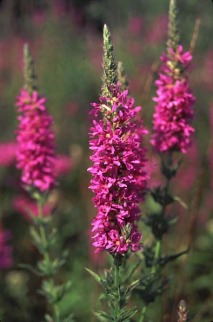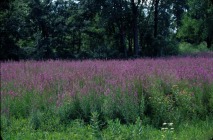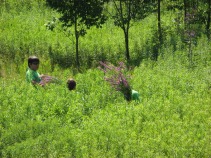Purple loosestrife: an insidious beauty in Indiana
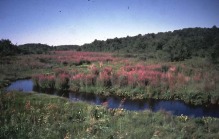 HOW TO IDENTIFY PURPLE LOOSESTRIFE: Purple loosestrife is a tall, hot pink flower blooming right now, usually in dense stands in sunny wetlands. It has branched, flowering, square stems and opposite leaves. The flowers have five to seven petals that flare back, and occur up and down the flowering stem rather than all at the top, like phlox. 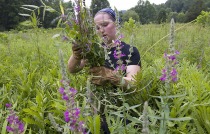 Hanna Joergens, an IU student and DNR volunteer, pulls a bunch of purple loosestrife from a field along T. C. Steele Road near Lake Monroe. The invasive plant is beautiful and colorful, and it wants to take over the world. It can out-compete native plants in wet areas. The DNR and other groups across the state are targeting it for eradication. David Snodgress | Herald-Times |
HeraldTimesOnline.com By Dawn Hewitt 331-4377 | [email protected] July 30, 2010
Wanted, dead not alive: A beautiful pink flower called purple loosestrife. Crime: Attempting to take over the world, damaging ecosystems and killing tadpoles. Reward: A healthy, biodiverse, natural ecosystem. Purple loosestrife is native to Great Britain, and it is found across central and southern Europe to central Russia, China, Japan, southeast Asia and northern India. It was introduced to North America in the early 1800s as an ornamental and medicinal plant; it’s now found in 47 states and most of Canada. It can still be purchased commercially in some states, but not here. In 1998, Indiana made it illegal to buy, sell or plant purple loosestrife or to distribute its seeds. What’s so bad about purple loosestrife? “Purple loosestrife displaces all the native plants in wetlands, which causes a real loss in diversity,” said Ellen Jacquert of Ellettsville, director of stewardship for the Indiana chapter of The Nature Conservancy and an expert on both exotic invasive and native plants. “A less obvious impact is that purple loosestrife changes the water chemistry of areas that it grows in, and those changes make species like American toad unable to change from tadpoles to adults,” she said. “The tadpoles all die because the chemistry changes cause the algae species to change, and the tadpoles can’t eat those species of algae.” According to the website of the Indiana Department of Natural Resources: “In optimum growing conditions, one small isolated patch of purple loosestrife can spread to cover an aquatic site in only one growing season. It easily adapts to any type of wetland. It crowds out native vegetation, commonly forming monotypic stands. “When wetland diversity is reduced, native wildlife is displaced. Purple loosestrife does not provide adequate cover for the animals associated with wetlands, nor does it provide a food source. Songbirds do not eat the seed; muskrats do not utilize the plant for building their homes; and waterfowl avoid areas that have been taken over by purple loosestrife. “This plant is capable of choking waterways and almost entirely eliminating open water habitat. Wetlands are the most diverse and productive ecosystem, but if purple loosestrife becomes established, the value of the wetland quickly degrades. It is estimated that each year more than one million acres of wetlands in the United States are taken over by purple loosestrife.” Seed machine Each purple loosestrife plant can produce up to 2.7 million seeds per year, according to the DNR. Each seed is the size of grain of sand that can be carried by the wind, bugs, birds, boat hulls, footwear, wildlife and pets. Seeds can remain dormant but viable for years. On the warpath Purple loosestrife is blooming right now, so this is a great time to seek and destroy it. And you can help. The first step in eradicating this beguiling demon is to locate it. A nationwide mapping project of exotic invasive plants is on the Web, and the Southern Indiana Cooperative Weed Management Area, a coalition of government agencies, universitites, companies and nonproft groups including Monroe County-Identify and Reduce Invasive Species, encourages everyone who finds purple loosestrife to report the location so it can be targeted for eradication. “Our hope is to get a good map of occurrences and over time, work to eliminate them,” Jacquart said. How to report purple loosestrife If you see a stand of purple loosestrife, please report it. E-mail Ellen Jacquart at [email protected]. Provide the location, with a map if possible, or else specific location information; the size of the infestation — how large an area it covers; your contact information; and a photo of the plant, if possible. Note that if the infestation is on private land, the landowner’s permission is required to report it. You can contribute to the mapping project at at www.eddmaps.org. Click on “distribution maps,” then scroll down to purple loosestrife (Lythrum salicaria) and click on it. On the map, click on Indiana, and then Monroe County, where you’ll see that several purple loosestrife locations have already been reported. To report a stand that isn’t click on “Join now” and set up a login. “You won’t be put on an e-mail list or anything — you just need to sign up to enter information,” said Ellen Jacquart. Then click “Report sightings” and type in where you found purple loosestrife. “It’s easy — took me five minutes to enter the site I put in,” Jacquart said. |
